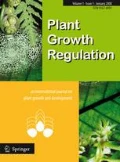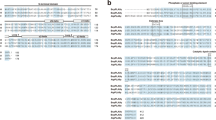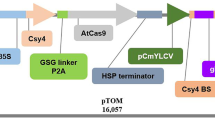Abstract
The ethylene receptor etr1-1 (ETHYLENE RESPONSE 1) mutant gene from Arabidopsis thaliana, with its expression under the control of either the Petunia floral binding protein FBP1 promoter or the Arabidopsis senescence-specific SAG12 gene promoter, was introduced into Pelargonium zonale cv. ‘Katinka’. The heterologous expression of these transgenes and the response of flowers and leaves to exogenous ethylene were then studied. Transgenic etr1-1 lines grown in the greenhouse did not differ morphologically or physiologically from nontransformed plants nor was the rooting ability of cuttings affected. Reverse transcription (RT)-PCR revealed that transcripts from an FBP1 promoter were present from green tissue to the roots, whereas the SAG12 promoter was only active in processes associated with aging or senescence of flower petals and leaves. The sensitivity to ethylene exposure was markedly reduced by using both promoter constructs. Flower petals from nontransformed controls were fully senescent 4 days after ethylene exposure, while more than 90% of the flower petals from FBP1-promoter lines and over 50% of the flower petals from SAG12-promoter lines remained unchanged, without showing any signs of wilting or any response to ethylene. However, ethylene sensitivity of leaves was only delayed in the best lines but not suppressed through etr1-1 expression. Foliage displayed less intense leaf yellowing and wilting, which were similar for both promoter variants compared to wild type controls.




Similar content being viewed by others
References
Albers F, Van der Walt JJA (2007) Geraniaceae. In: Kubitzki K (ed) The families and genera of vascular plants. IX Eudicots. Springer, Berlin, pp 157–167
Anderson R, Sanderson K, Smith D, Williams J (1993) Reduction of induced abscission of geranium (Pelargonium hortorum) petals and snapdragon (Anthirrinum majus) florets using three anti-ethylene compounds. Plant Growth Reg Soc Am Quart 21:144–150
Angenent GC, Busscher M, Franken J, Mol JNM, van Tunen AJ (1992) Differential expression of two MADS box genes in wild-type and mutant petunia flowers. Plant Cell 4:983–993
Angenent GC, Franken J, Busscher M, Colombo L, van Tunen AJ (1993) Petal and stamen formation in petunia is regulated by the homeotic gene fbp. Plant J 4:101–112
Bertani G (1951) Studies on lysogenesis. I. The mode of phage liberation by lysogenic Escherichia coli. J Bacteriol 62:293–300
Boase MR, Harriman RW, Smith FD, Deroles SC (2012) Herbicide-resistant, transgenic zonal pelargoniums produced by step-down glyphosate selection and plantlet recovery in the presence of aromatic amino acids. In Vitro Cell Dev-Pl 48:313–323
Bovy AG, Angenent GC, Dons HJM, van Altvorst AC (1999) Heterologous expression of the Arabidopsis etr1-1 allele inhibits the senescence of carnation flowers. Mol Breed 5:301–308
Calderini O, Bovone T, Scotti C, Pupilli F, Piano E, Arcioni S (2007) Delay of leaf senescence in Medicago sativa transformed with the ipt gene controlled by the senescence-specific promoter SAG12. Plant Cell Rep 26:611–615
Cameron AC, Reid MS (1983) Use of silver thiosulfate to prevent flower abscission from potted plants. Sci Hortic 19:373–378
Cameron AC, Reid MS (2001) 1-MCP blocks ethylene-induced petal abscission of Pelargonium peltatum but the effect is transient. Postharvest Biol Technol 22:169–177
Chang C, Kwok SF, Bleecker AB, Meyerowitz EM (1993) Arabidopsis ethylene-response gene ETR1: similarity of product to two-component regulators. Science 262:539–544
Chang HS, Jones ML, Banowetz GM, Clark DG (2003) Overproduction of cytokinins in petunia flowers transformed with PSAG12-IPT delays corolla senescence and decreases sensitivity to ethylene. Plant Physiol 132:2174–2183
Clark DG, Richards C, Hilioti Z, Lind-Iversen S, Brown K (1997) Effect of pollination on accumulation of ACC synthase and ACC oxidase transcripts, ethylene production and flower petal abscission in geranium (Pelargonium × hortorum LH Bailey). Plant Mol Biol 34:855–865
Clark DG, Gubrium EK, Barrett JE, Nell TA, Klee HJ (1999) Root formation in ethylene-insensitive plants. Plant Physiol 121:53–59
Cobb D, Schneiter N, Guo S, Humiston GA, Harriman B, Bolar J (2002) Flower specific expression of an ethylene receptor (ETR1-1) confers ethylene insensitivity in transgenic petunia. In: The Abstract of XVI International Horticultural Congress, Toronto, Canada, p 83
Cowan AK, Freeman M, Björkman PO, Nicander B, Sitbon F, Tillberg E (2005) Effects of senescence-induced alteration in cytokinin metabolism on source-sink relationships and ontogenic and stress-induced transitions in tobacco. Planta 221:801–814
Cuquel FL, Minami K, Clark DG (2002) Leaf senescence in putative transgenic petunia plants containing the PSAG12-kn1 gene. In: XXVI International Horticultural Congress: Biotechnology in Horticultural Crop Improvement: Achievements, Opportunities and Limitations, Toronto, Canada, pp 371–378
Deneke CF, Evensen KB, Craig R (1990) Regulation of petal abscission in Pelargonium × domesticum. HortScience 25:937–940
Evensen KB (1991) Ethylene responsiveness changes in Pelargonium × domesticum florets. Physiol Plant 82:409–412
Evensen KB, Page AM, Stead AD (1993) Anatomy of ethylene-induced petal abscission in Pelargonium × hortorum. Ann Bot 71:559–566
Gan SS, Amasino RM (1995) Inhibition of leaf senescence by autoregulated production of cytokinin. Science 270:1986–1988
Garcia-Sogo B, Pineda B, Roque E, Anton T, Atares A, Borja M, Beltran JP, Moreno V, Canas LA (2012) Production of engineered long-life and male sterile Pelargonium plants. BMC Plant Biol 12:156
Gramma J, Guo J, Huffner F, Niedermeier R, Piepho HP, Schmid R (2007) Algorithms for compact letter displays: comparison and evaluation. Comput Stat Data Anal 52:725–736
Grbić V, Bleecker AB (1995) Ethylene regulates the timing of leaf senescence in Arabidopsis. Plant J 8:595–602
Hothorn T, Bretz F, Westfall P (2008) Simultaneous inference in general parametric models. Biom J 50:346–363
Kim JH, Botella JR (2004) Etr1-1 gene expression alters regeneration patterns in transgenic lettuce stimulating root formation. Plant Cell Tissue Organ Cult 78:69–73
Kim H-J, Craig R, Brown KM (2007) Ethylene resistance of Regal Pelargonium is complemented but not replaced by 1-MCP. Postharvest Biol Technol 45:66–72
Koyama T (2014) The roles of ethylene and transcription factors in the regulation of onset of leaf senescence. Front Plant Sci 5:650
Kuckenberg J, Tartachnyk I, Noga G (2009) Detection and differentiation of nitrogen-deficiency, powdery mildew and leaf rust at wheat leaf and canopy level by laser-induced chlorophyll fluorescence. Biosyst Eng 103:121–128
Lenth RV (2016) Least-squares means: the R Package lsmeans. J Stat Softw 69:1–33
Loh FCW, Grabosky JC, Bassuk NL (2002) Using the SPAD 502 meter to assess chlorophyll and nitrogen content of benjamin fig and cottonwood leaves. Hortic Technol 12:682–686
McCabe MS, Garratt LC, Schepers F, Jordi WJ, Stoopen GM, Davelaar E, van Rhijn JHA, Power JB, Davey MR (2001) Effects of PSAG12-IPT gene expression on development and senescence in transgenic lettuce. Plant Physiol 127:505–516
Mithila J, Murch SJ, KrishnaRaj S, Saxena PK (2001) Recent advances in Pelargonium in vitro regeneration systems. Plant Cell Tiss Organ Cult 67:1–9
Murashige T, Skoog F (1962) A revised medium for rapid growth and bio assays with tobacco tissue cultures. Physiol Plant 15:473–497
Mutui TM, Mibus H, Serek M (2005) Effects of thidiazuron, ethylene, abscisic acid and dark storage on leaf yellowing and rooting of Pelargonium cuttings. J Hortic Sci Biotechnol 80:543–550
Olsen A, Lütken H, Hegelund JN, Müller R (2015) Ethylene resistance in flowering ornamental plants—improvements and future perspectives. Hortic Res 2:15038
Price AM, Orellana DFA, Salleh FM, Stevens R, Acock R, Buchanan-Wollaston V, Stead AD, Rogers HJ (2008) A comparison of leaf and petal senescence in wallflower reveals common and distinct patterns of gene expression and physiology. Plant Physiol 147:1898–1912
Rodriguez FI, Esch JJ, Hall AE, Binder BM, Schaller GE, Bleecker AB (1999) A copper cofactor for the ethylene receptor ETR1 from Arabidopsis. Science 283:996–998
Sanikhani M, Mibus H, Stummann BM, Serek M (2008) Kalanchoe blossfeldiana plants expressing the Arabidopsis etr1-1 allele show reduced ethylene sensitivity. Plant Cell Rep 27:729–737
Schaarschmidt F, Djira GD (2016) Simultaneous confidence intervals for ratios of fixed effect parameters in linear mixed models. Commun Stat Simul 45:1704–1717
Seglie L, Sisler EC, Mibus H, Serek M (2010) Use of a non-volatile 1-MCP formulation, N,N-dipropyl(1-cyclopropenylmethyl)amine, for improvement of postharvest quality of ornamental crops. Postharvest Biol Technol 56:117–122
Serek M, Prabucki A, Sisler EC, Andersen AS (1998) Inhibitors of ethylene action affect final quality and rooting of cuttings before and after storage. HortScience 33:153–155
Serek M, Woltering EJ, Sisler EC, Frello S, Sriskandarajah S (2006) Controlling ethylene responses in flowers at the receptor level. Biotechnol Adv 24:368–381
Sriskandarajah S, Mibus H, Serek M (2007) Transgenic Campanula carpatica plants with reduced ethylene sensitivity. Plant Cell Rep 26:805–813
Thomas H (2013) Senescence, ageing and death of the whole plant. New Phytol 197:696–711
van Doorn WG, Stead AD (1997) Abscission of flowers and floral parts. J Exp Bot 48:821–837
Wang KL-C, Li H, Ecker JR (2002) Ethylene biosynthesis and signaling networks. Plant Cell 14:S131–S151
Weaver LM, Gan S, Quirino B, Amasino RM (1998) A comparison of the expression patterns of several senescence-associated genes in response to stress and hormone treatment. Plant Mol Biol 37:455–469
Wilkinson JQ, Lanahan MB, Clark DG, Bleecker AB, Chang C, Meyerowitz EM, Klee HJ (1997) A dominant mutant receptor from Arabidopsis confers ethylene insensitivity in heterologous plants. Nat Biotechnol 15:444–447
Williams JGK, Kubelik AR, Livak KJ, Rafalski JA, Tingey SV (1990) DNA polymorphisms amplified by arbitrary primers are useful as genetic markers. Nucleic Acids Res 18:6531–6535
Winkelmann T, Kaviani K, Serek M (2005) Development of a shoot regeneration protocol for genetic transformation in Pelargonium zonale and Pelargonium peltatum hybrids. Plant Cell Tissue Organ Cult 80:33–42
Winkelmann T, Warwas M, Raffeiner B, Serek M, Mibus H (2016) Improved postharvest quality of inflorescences of fbp1::etr1-1 transgenic Burrageara ‘Stefan Isler Lava Flow’. J Plant Growth Regul 35:390–400
Woltering E (1987) Effects of ethylene on ornamental pot plants: a classification. Sci Hortic 31:283–294
Zahn LM, Leebens-Mack J, dePamphilis CW, Ma H, Theissen G (2005) To B or not to B a flower: The role of DEFICIENS and GLOBOSA orthologs in the evolution of the angiosperms. J Hered 96:225–240
Zakizadeh H, Lütken H, Sriskandarajah S, Serek M, Müller R (2013) Transformation of miniature potted rose (Rosa hybrida cv. Linda) with PSAG12-ipt gene delays leaf senescence and enhances resistance to exogenous ethylene. Plant Cell Rep 32:195–205
Zavaleta-Mancera HA, Franklin KA, Ougham HJ, Thomas H, Scott IM (1999) Regreening of senescent Nicotiana leaves: I. Reappearance of NADPH-protochlorophyllide oxidoreductase and light-harvesting chlorophyll a/b-binding protein. J Exp Bot 50:1677–1682
Acknowledgements
The authors would like to thank the technical and scientific staff of the Section Floriculture for fruitful discussions and technical assistance, Hermann Schmidt (DNA Cloning Service, Hamburg, Germany) for kindly providing the binary vector set, and Dr. Lynn Hoffman (Stellenbosch University, South Africa) for linguistic editing of the manuscript.
Author information
Authors and Affiliations
Corresponding author
Ethics declarations
Conflict of interest
The authors declare that they have no conflicts of interest.
Electronic supplementary material
Below is the link to the electronic supplementary material.
Rights and permissions
About this article
Cite this article
Gehl, C., Wamhoff, D., Schaarschmidt, F. et al. Improved leaf and flower longevity by expressing the etr1-1 allele in Pelargonium zonale under control of FBP1 and SAG12 promoters. Plant Growth Regul 86, 351–363 (2018). https://doi.org/10.1007/s10725-018-0434-0
Received:
Accepted:
Published:
Issue Date:
DOI: https://doi.org/10.1007/s10725-018-0434-0




